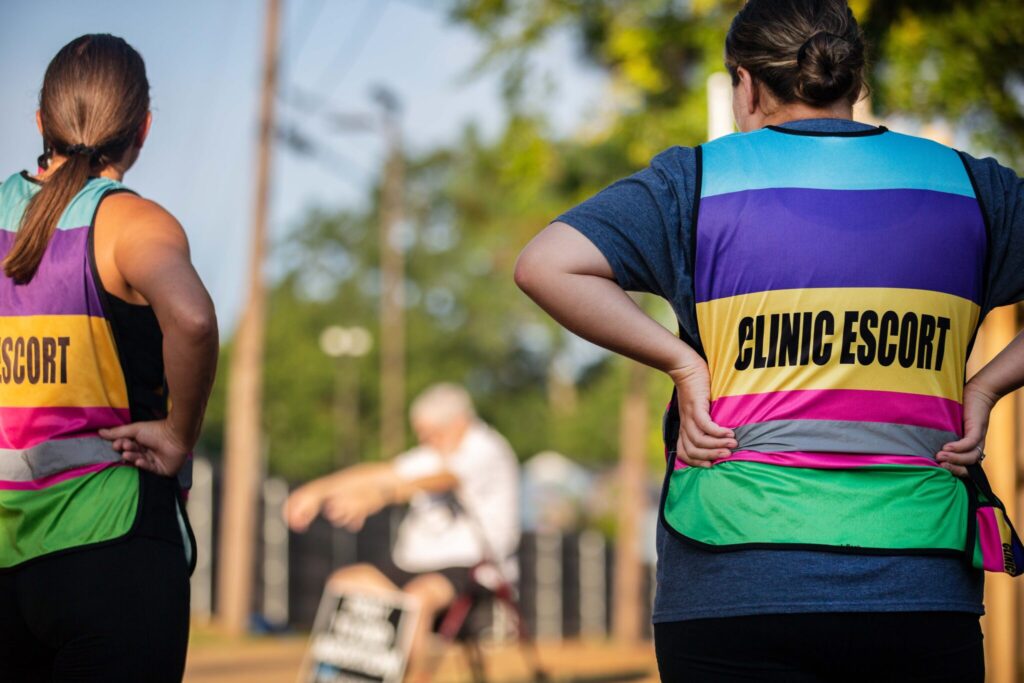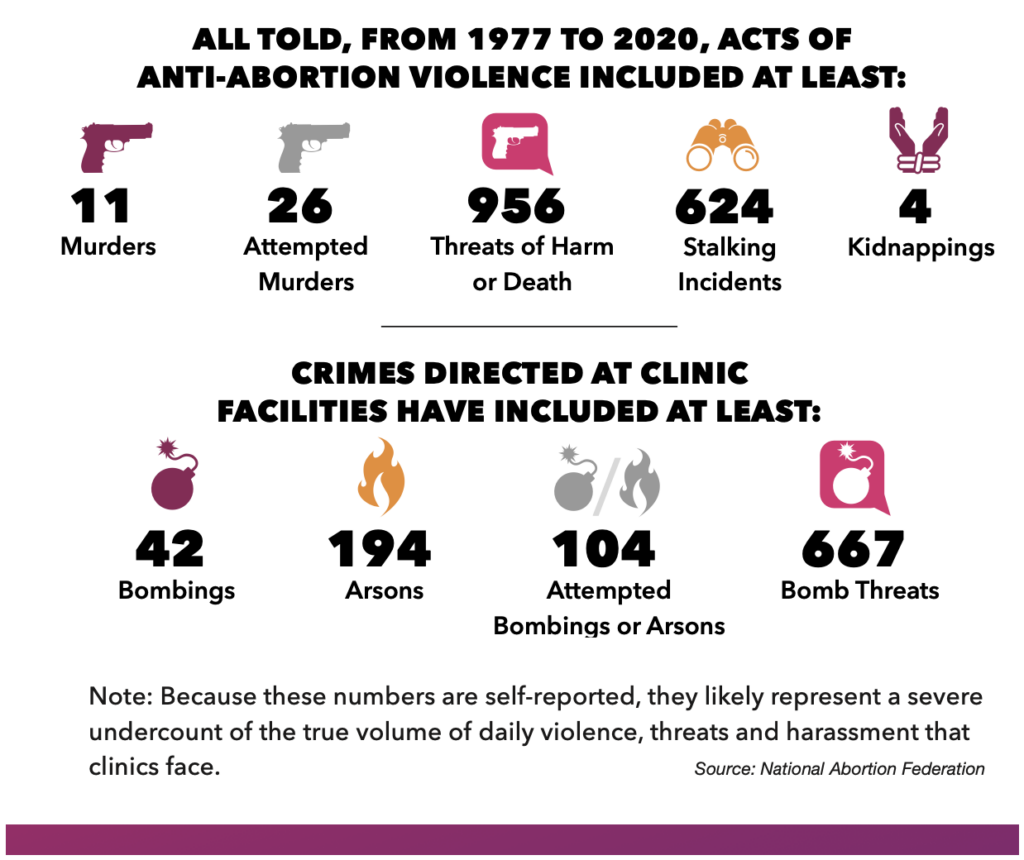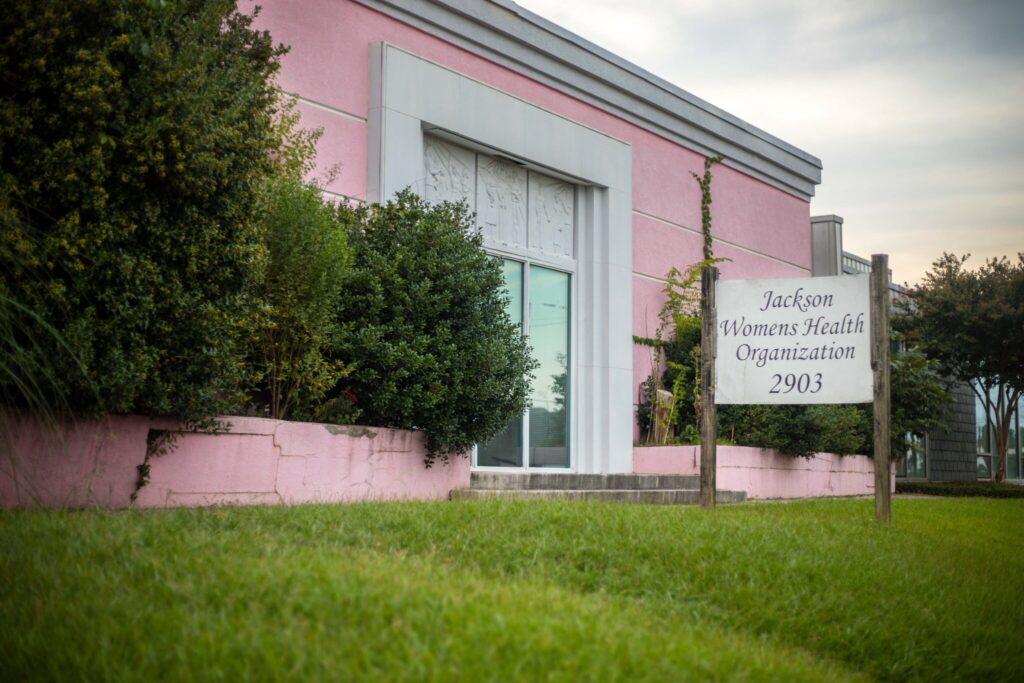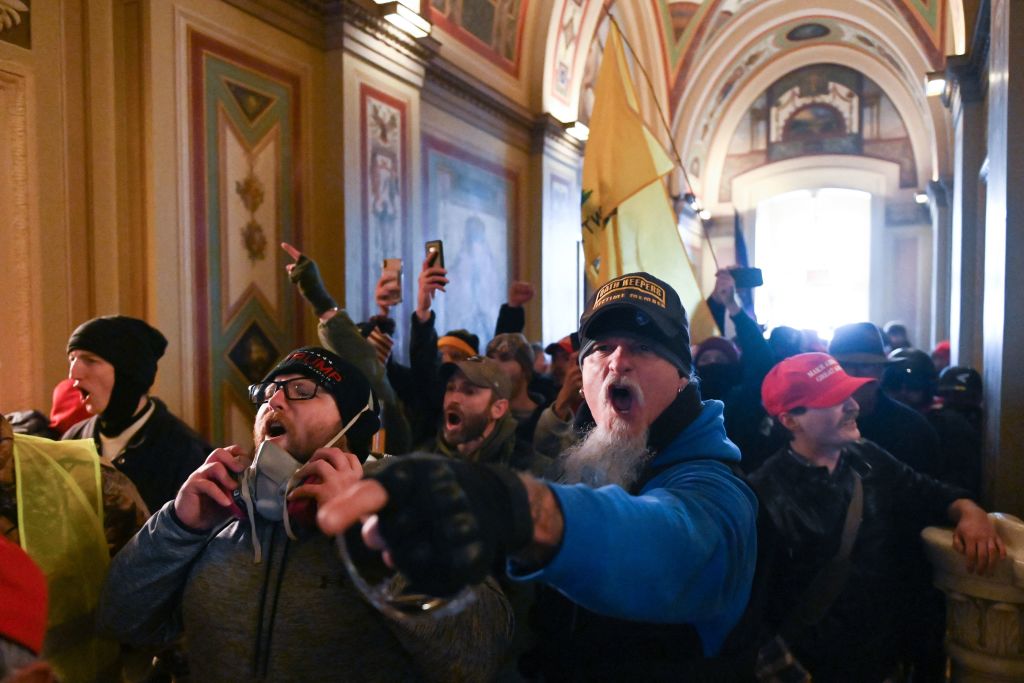In the face of the recent leak of a draft opinion that confirmed the Supreme Court is set to overturn Roe v. Wade, abortion advocates and providers are bracing for a surge in clinic violence.

In the face of Monday’s unexpected leak of a draft opinion from Justice Samuel Alito that confirmed that the Supreme Court is set to overturn Roe v. Wade, abortion advocates and providers are bracing for a surge in clinic violence. In a Wednesday call, officials with the FBI and Department of Homeland Security raised concerns about an increase in violent rhetoric from far-right aggressors in the wake of the draft opinion’s release. And private intelligence groups have released reports detailing violent reactions and threats to bomb clinics and hurt pro-abortion protestors on far-right online forums in response to the draft leak.
For nearly 50 years, as anti-abortion legislators in states around the country have chipped away at the constitutional right to a safe and legal abortion, they have done so with the steady drumbeat of violence at their back.
The Supreme Court heard arguments in the most recent attack on the constitutional right to abortion last December. The question in Dobbs v. Jackson Women’s Health Organization is whether Mississippi’s ban on pre-viability abortions is constitutional. Under the Supreme Court precedent set by Roe v. Wade in 1973 and reaffirmed in Planned Parenthood of Southeast Pennsylvania v. Casey in 1992, the answer is clearly no.
Though violence and threats of violence directed against abortion providers have been a prominent aspect of abortion in the United States since Roe was decided, anti-abortion legislators would like to ignore this history. Instead, they try to frame the history of post-Roe abortion as a “hard issue” and one of mere “controversy” that should be settled by these same state legislators. But decades of violence make clear that the debate over abortion in America isn’t a matter of some “civil disagreement.” It is the subject of unrelenting attacks by those who have no regard for the rule of law.
Though violence and threats of violence directed against abortion providers have been a prominent aspect of abortion in the U.S. since Roe was decided, anti-abortion legislators would like to ignore this history.
In the decision expected within the next few months, if the Supreme Court overturns or severely guts Roe v. Wade, it will send an unmistakable and dangerous message: that the violence against abortion providers has worked.

Mississippi provides a dramatic illustration of how extremists have employed violence and other lawlessness to reduce access to abortion. After a rapid expansion of abortion services in Mississippi in the years immediately following Roe, anti-abortion extremists waged a campaign that included stalking, intimidation and violence against doctors who provided abortion care.
This campaign was not isolated or sporadic but sustained and pervasive. The campaign of violence and threats was effective, coinciding with a sharp decline in the provision of and access to abortion services in Mississippi. In fact, Jackson Women’s Health Organization—now the last remaining abortion clinic in Mississippi and the target of the law at issue in Dobbs—was established in response to the clinic closures that resulted from this anti-abortion violence. At the time of its founding, only one other provider offered abortions for Mississippi residents.

Although Mississippi stands at the heart of the current attack on the constitutional right to abortion, violence against reproductive health providers and clinics has cast a shadow across the entire country. March 10, 1993, marked the first-known time in the U.S. that an anti-abortion extremist committed murder. Michael Griffin joined an anti-abortion protest at a reproductive healthcare clinic in Pensacola, Fla., and then fatally shot Dr. David Gunn in the back as the doctor was walking into the clinic.
Just over a year after Gunn was murdered, Dr. John Britton and Ret. Lt. Col. James Barrett, a volunteer clinic escort and a veteran of World War II and the Korean and Vietnam wars, were gunned down in the parking lot of another Pensacola clinic. Barrett’s wife, who saw her husband and Britton murdered, was shot in the arm.
Although Mississippi stands at the heart of the current attack on the constitutional right to abortion, violence against reproductive health providers and clinics has cast a shadow across the entire country.
In December 1994, an anti-abortion extremist opened fire on two clinics in Massachusetts, killing both clinics’ receptionists—Shannon Lowney and Leanne Nichols—and wounding five others. In 1998, Eric Rudolph, who bombed the Olympic Games, a clinic, and a lesbian and gay bar in Atlanta, detonated a bomb at a clinic in Birmingham, Ala., killing off-duty police officer Robert Sanderson, who served as a security guard at the clinic, and critically injuring a nurse. In 1998, a sniper murdered Dr. Barnett Slepian in front of his family as he was standing in the kitchen of his home in upstate New York.
On a Sunday at the end of May 2009, Dr. George Tiller was attending services at his church in Wichita, Kan., when anti-abortion extremist Scott Roeder entered the church, raised a gun to Tiller’s forehead and shot him at point-blank range. Tiller had survived being shot in both arms by a different anti-abortion extremist in 1993.

This article originally appears in the Winter 2022 issue of Ms. Become a member today to read more reporting like this in print and through our app.
Most recently, Robert Lewis Dear Jr. traveled to the Planned Parenthood clinic in Colorado Springs, Colo., with four SKS rifles, five handguns, two additional rifles, a shotgun, more than 500 rounds of ammunition and propane tanks, intending to wage “war” on the clinic because it offered abortion services. Dear shot at six peo- ple outside the clinic, killing two and injuring three more. He then shot his way into a clinic entrance while 27 healthcare providers, employees, patients and their companions attempted to hide, one of whom was shot during the course of the attack.
In the approximately five-hour standoff that ensued, Dear turned his weapons on law enforcement, shooting and killing one officer and injuring four more. In total, Dear fired 198 bullets during the attack. According to Dear’s documented interview with the police, he was “happy with what he had done because his actions … ensured that no more abortions would be conducted at the Planned Parenthood facility in Colorado Springs.”
The murders are, of course, the highest-profile examples of violence against reproductive health providers and clinics, but they alone don’t come close to telling the full story of the unrelenting, daily violence and harassment that anti-abortion extremists visit on providers and clinics. Attempted murder, death threats, stalking, kidnapping, bombings and arson are a routine part of life for providers and clinics.
And disturbingly, studies show that violence and threats have not only continued in recent years, but have risen.
A steady stream of examples illustrates the ever-present risk to providers, patients, staff and the public. In 2019, a 17-year-old in Texas was arrested after threatening to “commit jihad on an abortion clinic.” An Ohio man was charged with threatening to assault federal law enforcement officers after he made online threats against Planned Parenthood and others; authorities recovered more than a dozen rifles and 10,000 rounds of ammunition from his home.
In 2020, a Rhode Island man was sentenced to federal prison for stalking and sending threats after he threatened to torture and kill a university professor who supported abortion rights, and left more than 100 threatening voice mails for a clinic. And in 2021, a Delaware man pleaded guilty to federal charges after he threw a Molotov cocktail through a clinic’s window and painted a slogan associated with white supremacist groups on the clinic’s wall.
Anti-abortion extremists have employed and continue to employ violence and threats as part of a deliberate strategy to reduce or eliminate abortion, with a concerning number of anti-abortion extremists openly endorsing violence. Shortly after Gunn was murdered by Griffin in 1993, a statement signed by 34 extremists was released, stating:
“We, the undersigned, declare the justice of taking all godly action necessary to defend innocent human life including the use of force. We proclaim that whatever force is legitimate to defend the life of a born child is legitimate to defend the life of an unborn child. We assert that if Michael Griffin did in fact kill David Gunn, his use of lethal force was justifiable provided it was carried out for the purpose of defending the lives of unborn children. Therefore, he ought to be acquitted of the charges against him.”
Over the years since, several more versions of the statement were released, each time adding more extremists as signers.
Anti-abortion extremists have also expanded the targets of their violence beyond abortion providers. A number of prominent anti-abortion extremists were among those who participated in the siege of the U.S. Capitol on Jan. 6, 2021. Individuals interviewed outside the Capitol that day cited their anti-abortion views as the reason they traveled to Washington, D.C., with one person explaining that her decision to come to the Capitol was, in part, “to fight for the unborn.” Another extremist who filmed himself at the Capitol that day was previously convicted of planning to bomb an abortion clinic in 1988, and later admitted to setting fire to that clinic and another.

Violence has also been directed toward the Supreme Court. A shot was fired through the window of Justice Harry Blackmun’s home following years of death threats that began when he wrote the Court’s decision in Roe.
Extremists have used these acts of violence and other illegal tactics to further their goal of stopping abortion by reducing or eliminating access to abortion services, which disproportionately impacts low-income women, women of color and teenage girls. Over time, the violence has contributed to a substantial reduction in the number of clinics as well as the number of physicians and other clinic staff able and willing to perform abortions. Many doctors trained to provide abortion care opt not to do so to avoid subjecting themselves to harassment and violence, and other trained providers are leaving the practice due to the stress and burdens of living with the constant threat of violence.
As one doctor explained, she stopped providing abortions altogether because she was attacked on the internet and “hunted down by protesters” who broke into her home and left behind dead animals.
Anti-abortion extremists have employed and continue to employ violence and threats as part of a deliberate strategy to reduce or eliminate abortion, with a concerning number of anti-abortion extremists openly endorsing violence.
There is a real risk that overturning Roe would further embolden extremists to engage in violence in their crusade to end abortion in the United States. While some states would ban all or nearly all abortions if Roe is overturned, many states would continue to allow abortion, and there is little question that providers in those states would remain targets of violence.
After all, extremist violence has not been confined to those jurisdictions that would be expected to curtail abortion rights if Roe is overturned. Six of the murders committed by anti-abortion extremists occurred in jurisdictions that would likely preserve access to abortion: Colorado, Massachusetts and New York. If anti-abortion sentiments are unable to sway legislators in some states to ban abortion outright, there are very real reasons to be concerned that extremists—who for decades have disregarded the rule of law and legitimate political process—will take matters into their own hands.
The Feminist Majority Foundation (publisher of Ms.) and a number of other women’s and civil rights organizations, represented by pro bono counsel John Hall, Elizabeth Saxe, David Zionts, Kate Thompson, Molly Doggett, Marisa Tashman and Megan Keenan of Covington & Burling LLP, filed an amicus brief with the Court last fall in Dobbs to ensure that this long, devastating history of violence is not ignored as the Supreme Court considers the most serious challenge to the constitutional right to abortion care in a generation.
In 1992, when the Supreme Court reaffirmed Roe in Casey, it said it could not “overrule [precedent] under fire.” Overturning Roe now would, whatever the Court intends or says, be perceived as rewarding anti-abortion extremists’ violent acts and would undermine the rule of law. In Casey, the Court refused to overrule a landmark precedent under threat of violence. It should not do so now, a generation later, when even more anti-abortion violence has become an undeniable part of our nation’s history.
Sign and share Ms.’s relaunched “We Have Had Abortions” petition—whether you yourself have had an abortion, or simply stand in solidarity with those who have—to let the Supreme Court, Congress and the White House know: We will not give up the right to safe, legal, accessible abortion.
Up next:





